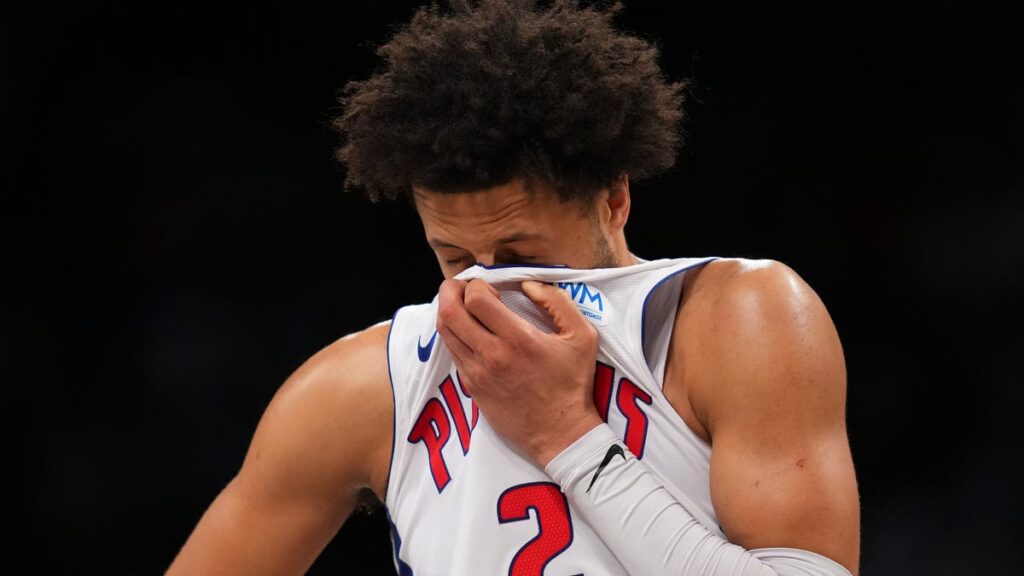When the Detroit Pistons put their mind to losing, nobody has been better for the last decade, but they’ve outdone themselves now by recklessly assembling one of the worst examples of an ill-fitting roster in a league now predicated on spacing, efficient scoring at the rim or behind the arc, and adaptable lineups.
Detroit’s 26th straight loss over the holiday weekend to the Brooklyn Nets tied them with the 2010-11 Cleveland Cavaliers and the 2013-14 Philadelphia 76ers for the longest single-season losing streak in league history. They still have deeper depths to plumb. With two more losses, they’d crack the Sixers 28-game stretch over the 2014-15 and 2015-16 seasons. With their next three games against the Nets, Celtics and Pistons. They will likely shatter that milestone by the New Year.
The aforementioned Cavs were peeling themselves off the mat after LeBron James bolted for Miami in a primetime TV event. The Sixers were in the inaugural season of their most trying Process seasons. This losing streak is the most relevant the Pistons have been since their last playoff win in 2008.
When Pistons owner Tom Gores appointed Troy Weaver as the architect of their reconstruction, he’d plucked away a veteran Thunder exec who’d spent a decade learning the dark arts of evaluating prospects from Sam Presti.
“Troy is an outstanding executive with an exceptional track record for identifying and developing talent,” said Gores in a statement.
Jim Boeheim offered up effusive praise of Weaver, who was instrumental in Syracuse identifying Carmelo Anthony before he exploded on the recruiting circuit.
“Anyone can spot LeBron and know he’s good, but not everyone knew Steph Curry was going to be really good. Troy has an eye. He’s a great evaluator of both players and people,” Boeheim told The Athletic after Weaver was introduced as the Pistons GM.
Unfortunately, it hasn’t played out that way. Today, Presti is presiding over a mine rife with diamonds in the form of players approaching their primes. While the Thunder are cruising at a flying altitude, Weaver’s Pistons are mole people. The Motor City’s Little Caesars Arena is a nightly pro basketball doomsday bunker. The Charlotte Hornets, owners of the second-longest active losing streak, have lost only seven in a row.
The San Antonio Spurs are only 30 games into their French Revolution, but have a cornerstone to build around and a head coach whose system rang in five championship parades between 1999 and 2014. The Washington Wizards dwelled in limbo for one season too long, but are invested in Tank Jordan and Tank Pippen, aka Jordan Poole and Kyle Kuzma for the near future.
However, the Pistons have lost nearly 75 percent of their games dating back to the beginning of the pandemic. Since 2019, they’ve dropped 40 more games than the Wizards, the NBA’s worst team in that span.
This isn’t a matter of tinkering. Their entire blueprint is flawed. The Crash Brothers, Cade Cunningham, Ausar Thompson and Jaden Ivey are the league’s coldest shooting backcourt. Overall, the Pistons shoot the NBA’s lowest percentage from downtown, while hoisting the fewest attempts per game and began their season fielding a two-big lineup including Jalen Duren and Isaiah Stewart.
For some bizarre reason, they became a willing repository of other team’s lottery waste. The totality of their roster includes eight recent top-10 picks.
Kevin Knox fell out of favor quickly in New York, was eventually pushed from the rotation and signed with the Pistons in 2022 before Detroit subsequently traded Knox to the Portland Trail Blazers at the deadline in the four-team James Wiseman deal. During the offseason, Knox signed with the Pistons again. Jaden Ivey has been in and out of the rotation, but he’s a Bugatti who thrives when he’s driving the lane. Veteran Bojan Bogdanovic is the only above average shooter in Monty Williiams’ rotation, but at 34, he doesn’t factor into their long-term plans.
Jumbo guard Killian Hayes is still in developmental hell, chucking a career-high .467 effective field goal percentage. At his best, he’s cementing his status as a bottom-30 shooter in the league. Hayes’ playmaking ability as a jumbo guard is what pushed him into the lottery, but his severe limitations as a bucket-getter played a large part in propelling the Pistons towards drafting Cunningham number one overall in 2020.
During the 2022 offseason, they outbid themselves for Marvin Bagley by offering a three-year, fully guaranteed deal to a former No. 2 pick who isn’t a threat outside the lane, is completely devoid of playmaking ability and is a negative defender.
Ausar Thompson is a jaw-dropping athlete, but anyone who watched him build mansions in Overtime Elite knew that he was one of the prolific bricklayers in the draft. For what it’s worth, Thompson is a bouncy slasher who could fill up the stat sheet on both ends without a functioning jumper. But Weaver pairing a future all-universe defender, who now makes only 20 percent of his attempts from downtown with one of the worst shooting lineups in the modern NBA, just contributes to the deformities of this roster. Throw in a quartet of one-dimensional bigs, and you have the spark for a basketball Chernobyl.
Trading for Wiseman months after receiving Jalen Duren in a Draft Day trade to pair with Isaiah Stewart was incomprehensible given the makeup of this team. The latter is more of a perimeter threat than Duren or Wiseman, but defensively he puts the Pistons at a disadvantage whether he’s patrolling the paint or eating fumes as quicker forwards zoom by him.
Three years after they took Cunningham first overall, Detroit is digging themselves deeper into a hole. After losing the Victor Wembanyama sweepstakes, despite owning the league’s worst record by five games, they’ll have to get lucky in a draft devoid of upper-echelon prospects.
If the Pistons don’t find a lifeline in the draft, their fate rests on the development of Cunningham. On the plus side, Cunningham is a multifaceted point guard in a small forward’s body, who plays a cerebral brand of basketball.
Cunningham recently became the sixth player in NBA history to record 1,800 points, 600 assist and 500 rebounds in his first 100 games. Luka Doncic, Magic Johnson, Oscar Robertson, LeBron James and Steve Francis round out an impressive list. However, here’s the rub. Of those six players, Cunningham’s true shooting percentage tells the tale of a talent who is more suited to be a lieutenant than a heliocentric five-star floor general.
Through their first 100 games, Cunningham sticks out like a sore thumb when you examine how he stacks up to that group according to their respective effective field goal percentages, which weighs 3-point shooting more heavily, and true shooting percentage which factors in free throws.
His .312 career 3-point average ranks 139th out of 140 of the worst among high-volume shooters who took at least 500 triples since he entered the league. He leads the league in turnovers, and in year three, he lags behind in getting to the free throw line, he’s clanking iron behind the arc at a prolific rate and has been atrocious finishing in the lane despite his immense size and length. This season, through 29 games he’s had his shot rejected more than any player in the league except for Jaren Jackson. Detroit has a conundrum on their hands. At times, Cunningham just fades into the background.
There’s no way Weaver survives this structural disaster. Inevitably, he will leave behind an irradiated roster. When the Pistons finally win a game, someone will have to dig them out of this rubble and Cunningham isn’t capable of doing it alone.




